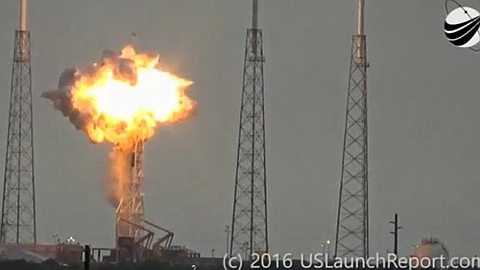SpaceX Investigating Cause of Falcon 9 Rocket Explosion

Falcon 9 Rocket Explosion
The powerful explosion destroyed both the two-stage Falcon 9 and the Amos-6 communications satellite, which the rocket was scheduled to launch from Florida's Cape Canaveral Air Force Station on Saturday (Sept. 3). Nobody was injured, SpaceX representatives said.
"Loss of Falcon vehicle today during propellant fill operation. Originated around upper-stage oxygen tank. Cause still unknown. More soon," SpaceX founder and CEO Elon Musk said yesterday via his Twitter account, @elonmusk.
"We are continuing to review the data to identify the root cause. Additional updates will be provided as they become available," SpaceX representatives added in a statement the company posted on Twitter.
SpaceX last lost a Falcon 9 on June 28, 2015, when the rocket broke apart less than 3 minutes after launching the company's robotic Dragon cargo capsule toward the International Space Station for NASA.
It took several weeks to nail down the cause of that accident. Musk announced on July 20, 2015, that SpaceX had traced the problem to a faulty steel strut inside the Falcon 9's upper stage. This strut — one of hundreds aboard the rocket — snapped, allowing a bottle of high-pressure liquid helium to shoot to the top of the Falcon 9's upper-stage liquid-oxygen tank, Musk said at the time.
In the aftermath of the accident, SpaceX decided to test and certify every single such strut that goes into a Falcon 9, he added.
A Falcon 9 didn't fly again after the June 2015 explosion until Dec. 21, when the rocket successfully lofted 11 satellites for the company Orbcomm — and the Falcon 9 first stage came back to Cape Canaveral and pulled off the first-ever soft landing during an orbital launch. (SpaceX is working to make its boosters fully and rapidly reusable, in an effort to slash the cost of spaceflight.)
The Dec. 21 mission marked the maiden flight of a significantly upgraded version of the Falcon 9 that had been in the works for some time — one known as "Full Thrust" that boasts increased power and an improved stage-separation system, among other features, Musk has said.
Falcon 9 Full Thrust vehicles had flown eight consecutive successful missions, many of them also featuring first-stage landings , before yesterday's accident.





